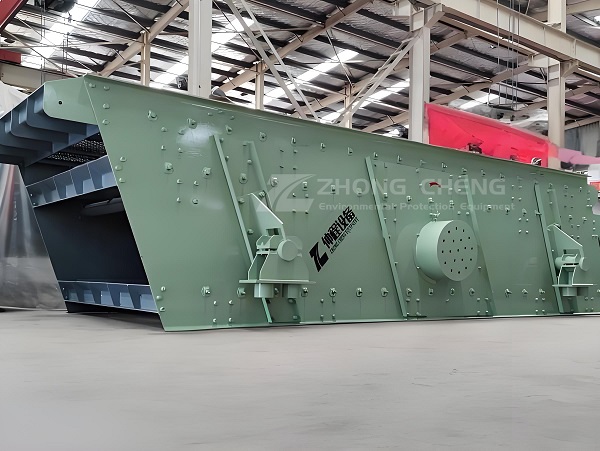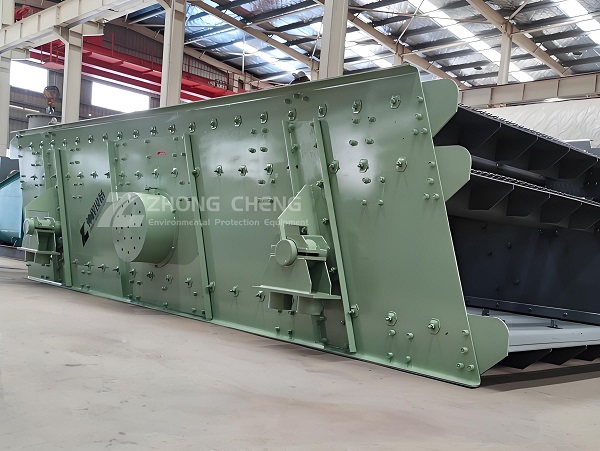Preface: Vibrating screen is a kind of mechanical equipment widely used in environmental protection, mining, metallurgy, chemical industry, building materials and other industries. Its main function is to classify and screen materials by vibration principle. The vibrating screen drives the exciter to vibrate through the motor, so that the material on the screen surface produces relative movement, thereby realizing the separation of particles of different sizes or properties. It has the advantages of high screening efficiency, large processing capacity, simple operation and convenient maintenance.
A. The role of vibrating screen
The vibrating screen plays a vital role in many industrial fields. Its main functions include the following aspects:

Vibrating screen from Zhongcheng Machinery
1. Material classification and screening:
The core function of the vibrating screen is to screen materials and effectively separate particles of different sizes or properties.
In the process of ore processing, coal washing, building material preparation, etc., the vibrating screen is used to classify raw materials according to particle size to meet the needs of subsequent processing or use.
2. Desludging, dehydration and demediation:
In the wet screening process, the vibrating screen can help the material remove excess water or medium.
For example, in coal washing, vibrating screens can be used to remove moisture from coal slime; in the mineral processing process, vibrating screens can be used to remove media from ore.
3. Pretreatment and pre-processing:
Vibrating screens are often used in the pre-processing stage of materials, such as pre-screening before crushing, to remove oversized or undersized particles and improve the efficiency and service life of the crusher.
In some chemical or food processing processes, vibrating screens are also used to remove impurities or unqualified particles from raw materials.
4. Energy saving and environmental protection:
By precisely controlling the screening process, vibrating screens can reduce energy consumption and improve screening efficiency.
At the same time, the design of vibrating screens often takes into account the reduction of noise and dust emissions, which meets environmental protection requirements.
5. Automation and intelligence:
Modern vibrating screens are usually equipped with advanced control systems that can realize automated operation and intelligent monitoring.
Through sensors and data analysis, vibrating screens can monitor the screening effect in real time and adjust working parameters to optimize screening performance and product quality.
6. Improve production efficiency and reduce costs:
The efficient screening capacity of vibrating screens can significantly improve production efficiency and reduce manual intervention and downtime.
Through precise screening, the vibrating screen can also reduce the production of excessive crushing and defective products, thereby reducing production costs.
The vibrating screen plays an indispensable role in industrial production. It not only improves the efficiency and accuracy of material handling, but also promotes the development of energy conservation, environmental protection and intelligence.
B. Working principle of vibrating screen
The working principle of the vibrating screen is mainly based on the principle of vibration, and the material is screened on the screen surface through vibration. The following is a detailed explanation of the working principle of the vibrating screen:

Vibrating screen from Zhongcheng Machinery
1. Basic composition of vibrating screen
The vibrating screen is mainly composed of screen box, screen mesh, screen frame, motor pedestal, shock-absorbing spring, bracket and other parts. Among them, the screen box is the main component for holding materials and screening, and the screen mesh is the key component for achieving material separation.
2. Vibration source of vibrating screen
The vibration source of the vibrating screen is usually an electric motor, which drives the exciter or heavy hammer to vibrate. The exciter is usually installed on the side plate of the screen frame and is the power source of the vibrating screen. When the motor starts, the eccentric block in the exciter rotates to generate centrifugal force, which is transmitted to the screen surface through the screen frame to form vibration.
3. Vibration track of the screen surface
Under the action of the exciter, the screen surface of the vibrating screen will produce complex vibration tracks. These tracks can be flat, three-dimensional, or even complex rotation, depending on the configuration of the exciter and the design of the screen surface. For example, the complex rotation vibrating screen uses the combined action of the upper rotating hammer and the lower rotating hammer to make the screen surface produce a composite effect of plane and conical rotation vibration, thereby enhancing the stratification and screening ability of the material.
4. Movement of materials on the screen surface
Under the action of vibration, the material moves relative to the screen surface. Due to the combined action of gravity, vibration force and friction, smaller particles of material are more likely to pass through the screen holes, while larger particles are left on the screen surface, thereby achieving material separation and grading. This form of movement makes the material constantly roll, jump and move forward on the screen surface, increasing the contact opportunities between the material and the screen surface and improving the screening efficiency.
5. Screening process
The process of passing a group of broken and scattered materials of different particle sizes through a single or multi-layer screen surface with uniform holes for multiple times and dividing them into several different levels is called screening. Particles larger than the sieve hole remain on the sieve surface, and particles smaller than the sieve hole pass through the sieve hole, finally achieving the separation of coarse and fine particles and completing the screening process.
The working principle of the vibrating screen is to use the motor to drive the vibrator or the heavy hammer to vibrate, so that the screen surface produces a complex vibration trajectory, so that the material moves relative to the screen surface and achieves separation and classification. This working principle makes the vibrating screen widely used in mining, metallurgy, chemical industry, building materials and other industries.
PS: The design of the vibrating screen also takes into account the needs of energy saving, environmental protection and intelligence to adapt to the development trend of modern industrial production. In industrial production, the vibrating screen plays an indispensable role and provides an efficient and reliable solution for material processing.
Save Time! Get A Detailed Quotation Quickly.
